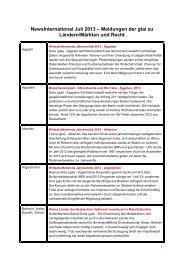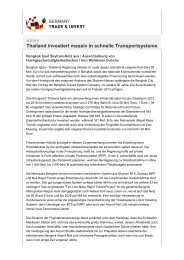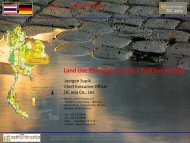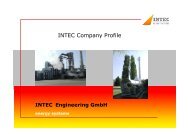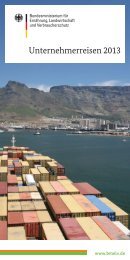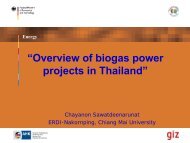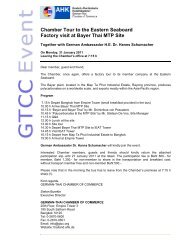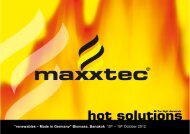Energy Saving and Low NOx Combustion Systems for
Energy Saving and Low NOx Combustion Systems for
Energy Saving and Low NOx Combustion Systems for
Create successful ePaper yourself
Turn your PDF publications into a flip-book with our unique Google optimized e-Paper software.
© 2012, WS<br />
<strong>Energy</strong> Efficiency in Thai Industries, 16/10/2012<br />
<strong>Energy</strong> <strong>Saving</strong> <strong>and</strong> <strong>Low</strong> <strong>NOx</strong><br />
<strong>Combustion</strong> <strong>Systems</strong> <strong>for</strong> Industrial<br />
Furnaces<br />
Klaus Läpple<br />
WS – Wärmeprozesstechnik GmbH<br />
Germany<br />
www.FLOX.com
Global presence <strong>and</strong> worldwide service<br />
Headquarter in Germany<br />
Distributor in Thail<strong>and</strong><br />
Further representatives in:<br />
- USA, Lorain, Ohio / - China, Shanghai / - Korea / - Japan / - Czech Republic /<br />
- France, Paris / - Italy, Torino / - Spain, Bilbao / - Brazil, Sao Paulo / - Russia,<br />
Moskau
How to fight high energy prices<br />
Source: DOE, commercial prices<br />
• Use the hot exhaust gases to<br />
preheat the combustion air<br />
• Heat unheated preheat zone<br />
• Use the exhaust gases to heat other<br />
processes<br />
• Oxy-fuel (recommended only <strong>for</strong> special<br />
conditions, not <strong>for</strong> general furnace<br />
applications)<br />
• Switch to alternative fuels
Efficiency of fuel fired furnaces<br />
� Many furnaces are operating at temperatures in a range<br />
from 800°C to 1.300°C<br />
� Exhaust gas temperature are often above 1.000°C<br />
� This means waste gas losses of > 50% without heat<br />
recovery<br />
heating system<br />
comparison<br />
natural<br />
gas,<br />
no air<br />
preheat<br />
natural<br />
gas,<br />
st<strong>and</strong>.<br />
preheat<br />
natural<br />
gas,<br />
opt.<br />
preheat<br />
* 1000°C furnace temperature; ** german energy mix (Source: BMWi); *** O2: 0,5 kWh el / m 3<br />
natural<br />
gas,<br />
O 2 ***<br />
electric<br />
heating<br />
waste gas losses* 50% 30% 15% 15% -<br />
losses in the power plant - - - 7% 58%<br />
primary energy** (norm.) 2 1,4 1,2 1,3 2,4<br />
CO 2 -emissions (norm.) 2 1,4 1,2 1,6 2,6
Solutions <strong>for</strong> air - preheat<br />
Self - recuperative burners: Regenerative burners:<br />
Main goals by WS:<br />
• High efficiency by minimizing waste gas losses<br />
• Minimal <strong>NOx</strong> emissions<br />
• Usability / reliability<br />
• <strong>Low</strong> cost of ownership <strong>and</strong> long lasting customer relationship
efficiency<br />
Efficiency<br />
0.75<br />
0.5<br />
0.25<br />
0<br />
1<br />
482 932 1382 1832 2282°F 2732<br />
REGEMAT ®<br />
� = 1<br />
0.2<br />
� = 0<br />
0.8<br />
0.6<br />
REKUMAT ® 0.4<br />
central heat exchanger<br />
rel. air preheat<br />
air preheat temperature<br />
� ~ exhaust temperature<br />
0<br />
0 250 500 750 1000 1250°C 1500<br />
exhaust temperature<br />
(prior to the heat exchanger)
Heat exchanger per<strong>for</strong>mance
Self recuperative burner – Rekumat C150
Recuperative Gap flow burner – Rekumat S200
Self regenerative burner - Regemat 250
Self regenerative burner – Regemat 350
Radiant tube designs<br />
„old“ designs „new“ designs
Double P tube with Rekumat M250
Continous strip lines
Strip line furnace<br />
equipped with WS - SISIC radiant tubes<br />
- internal - view -
Fuel cost estimate of a large strip line<br />
furnace (500.000 ton/year, € 5 / GJ)<br />
Strip target temp.: 800°C<br />
Heat to load: 0.50 GJ/t<br />
well tuned regenerative system: 0.70 GJ/t (€1.75 Mio.)<br />
well tuned recuperative system: 0.85 GJ/t (€2.125 Mio)<br />
st<strong>and</strong>ard system (plug in recu): 1 GJ/t (€2.5 Mio.)<br />
poor system (no heat recovery): >1.4 GJ/t (>€3.5 Mio.)
Nox – reduction / FLOX® vs. Flame Mode<br />
Rekumat <strong>and</strong> Regemat burner<br />
< 850°C = Flame Mode<br />
> 850°C = FLOX® - Mode<br />
Advantage:<br />
• drastic <strong>NOx</strong> - reduction<br />
(more than 90 %)<br />
• Thermal stress of the burner front<br />
is minimized<br />
• improved temperature uni<strong>for</strong>mity<br />
reacting fuel & air<br />
FLOX® is a registered trademark by WS<br />
fuel<br />
air
Conclusion<br />
The role of energy conservation will gain more importance in<br />
the future<br />
<strong>Combustion</strong> air preheat is the most effective method to<br />
increase efficiency<br />
Flameless oxidation enables low <strong>NOx</strong> <strong>and</strong> high efficiency<br />
Close cooperation of supplier <strong>and</strong> customer is essential<br />
There is a lot to do <strong>for</strong> R&D
... more in<strong>for</strong>mations ? www.FLOX.com<br />
Thank you, <strong>for</strong> your attention !



